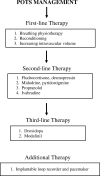Management of Postural Orthostatic Tachycardia Syndrome in the Absence of Randomized Controlled Trials
- PMID: 34327047
- PMCID: PMC8313187
- DOI: 10.19102/icrm.2021.120705
Management of Postural Orthostatic Tachycardia Syndrome in the Absence of Randomized Controlled Trials
Abstract
Postural orthostatic tachycardia syndrome (POTS) is a clinical syndrome causing patients to experience light-headedness, palpitations, tremors, and breathlessness upon assuming an upright posture. Despite the absence of available long-term, multicenter, randomized controlled trial data, this literature review aims to concisely present the nonpharmacological and pharmacological interventions that have been used in the treatment of POTS reported to date by cross-sectional studies, cohort studies, and retrospective studies. We attempt to classify treatments as first-, second-, and third-line therapies based on our own experience and available data.
Keywords: Managemen; nonpharmacological; pharmacological; postural orthostatic tachycardia syndrome.
Copyright: © 2021 Innovations in Cardiac Rhythm Management.
Conflict of interest statement
The authors report no conflicts of interest for the published content.
Figures

Similar articles
-
Perioperative care of an adolescent with postural orthostatic tachycardia syndrome.Saudi J Anaesth. 2010 Jan;4(1):23-7. doi: 10.4103/1658-354X.62611. Saudi J Anaesth. 2010. PMID: 20668563 Free PMC article.
-
Pharmacotherapy for postural tachycardia syndrome.Auton Neurosci. 2018 Dec;215:28-36. doi: 10.1016/j.autneu.2018.04.008. Epub 2018 May 4. Auton Neurosci. 2018. PMID: 29753556 Review.
-
Orthostatic intolerance and postural tachycardia syndrome: new insights into pathophysiology and treatment.Herzschrittmacherther Elektrophysiol. 2018 Jun;29(2):183-186. doi: 10.1007/s00399-018-0563-1. Epub 2018 Apr 25. Herzschrittmacherther Elektrophysiol. 2018. PMID: 29696346 Review. English.
-
A Case Report and Review of Postural Orthostatic Tachycardia Syndrome in Pregnancy.AJP Rep. 2015 Apr;5(1):e33-6. doi: 10.1055/s-0034-1544106. Epub 2015 Mar 4. AJP Rep. 2015. PMID: 26199795 Free PMC article.
-
[Postural tachycardia syndrome (PoTS): An up-to-date].Rev Med Interne. 2018 Aug;39(8):627-634. doi: 10.1016/j.revmed.2018.04.017. Epub 2018 Jun 13. Rev Med Interne. 2018. PMID: 29909001 Review. French.
Cited by
-
One or many labels? a longitudinal qualitative study of patients' journey to diagnosis at a specialist NHS Postural Tachycardia Syndrome (PoTS) clinic.PLoS One. 2024 Jul 10;19(7):e0302723. doi: 10.1371/journal.pone.0302723. eCollection 2024. PLoS One. 2024. PMID: 38985772 Free PMC article.
-
Narrative Review of Postural Orthostatic Tachycardia Syndrome: Associated Conditions and Management Strategies.US Cardiol. 2023 Sep 19;17:e13. doi: 10.15420/usc.2022.35. eCollection 2023. US Cardiol. 2023. PMID: 39559520 Free PMC article. Review.
-
Postural orthostatic tachycardia syndrome after COVID-19 vaccination: A systematic review.BMC Cardiovasc Disord. 2024 Nov 13;24(1):643. doi: 10.1186/s12872-024-04315-x. BMC Cardiovasc Disord. 2024. PMID: 39538129 Free PMC article.
References
-
- Sheldon RS, Grubb BP, 2nd, Olshansky B, et al. 2015 Heart Rhythm Society Expert Consensus Statement on the diagnosis and treatment of postural tachycardia syndrome, inappropriate sinus tachycardia, and vasovagal syncope. Heart Rhythm. 2015;12(6):e41–e63. [CrossRef] [PubMed] - DOI - PMC - PubMed
-
- Shaw BH, Stiles LE, Bourne K, et al. The face of postural tachycardia syndrome—insights from a large cross-sectional online community-based survey. J Intern Med. 2019;286(4):438–448. [CrossRef] [PubMed] - DOI - PMC - PubMed
-
- Zadourian A, Doherty TA, Swiatkiewicz I, et al. Postural orthostatic tachycardia syndrome: prevalence, pathophysiology, and management. Drugs. 2018;78(10):983–994. [CrossRef] [PubMed] - DOI - PubMed
-
- Kanjwal K, Karabin B, Kanjwal Y, et al. Autonomic dysfunction presenting as postural orthostatic tachycardia syndrome in patients with multiple sclerosis. Int J Med Sci. 2010;7(2):62–67. [CrossRef] [PubMed] - DOI - PMC - PubMed
-
- Billakanty SR, Kligman MD, Kanjwal YM, et al. New-onset orthostatic intolerance following bariatric surgery. Pacing Clin Electrophysiol. 2008;31(7):884–888. [CrossRef] [PubMed] - DOI - PubMed
LinkOut - more resources
Full Text Sources
